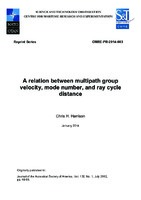| dc.contributor.author | Harrison, Chris H. | |
| dc.date.accessioned | 2018-10-11T14:09:46Z | |
| dc.date.available | 2018-10-11T14:09:46Z | |
| dc.date.issued | 2014/01 | |
| dc.identifier | 47927 | |
| dc.identifier.govdoc | CMRE-PR-2014-003 | |
| dc.identifier.uri | http://hdl.handle.net/20.500.12489/679 | |
| dc.description.abstract | Weston's ray invariant or "characteristic time" in a range-dependent environment is exactly equivalent to the Wentzel-Kramers-Brillouin phase integral for ducted normal modes. By considering a ray element it is shown that the ray invariant can also be written in terms of ray cycle distance and cycle time. This leads to a useful formula for group velocity in terms of cycle distance and mode number. Drawing a distinction between the ray and wave interpretation, the Airy phase (i.e., the existence of a group velocity minimum) can be included in this approach. Favorable comparisons are made with group velocities derived from a normal mode model. The relationship is valid for variable sound speed and variable bathymetry, and this is demonstrated numerically. The formula is applicable to active sonar, multipath pulse shape, target signatures, reverberation, tomography, and underwater communications. | |
| dc.format | 8 p. : ill. ; digital, PDF file | |
| dc.language | English | |
| dc.publisher | CMRE | |
| dc.source | In: Journal of the Acoustical Society of America, vol. 132, no. 1, July 2012, pp. 48-55. | |
| dc.subject | Underwater acoustics | |
| dc.subject | Acoustic propagation | |
| dc.subject | Ray acoustics | |
| dc.subject | Sound velocity in sea water | |
| dc.title | A relation between multipath group velocity, mode number, and ray cycle distance | |
| dc.type | Reprint (PR) | |
| dc.type | Papers and Articles | |
